新安全生产法(2014年修订)
- 格式:doc
- 大小:125.00 KB
- 文档页数:25
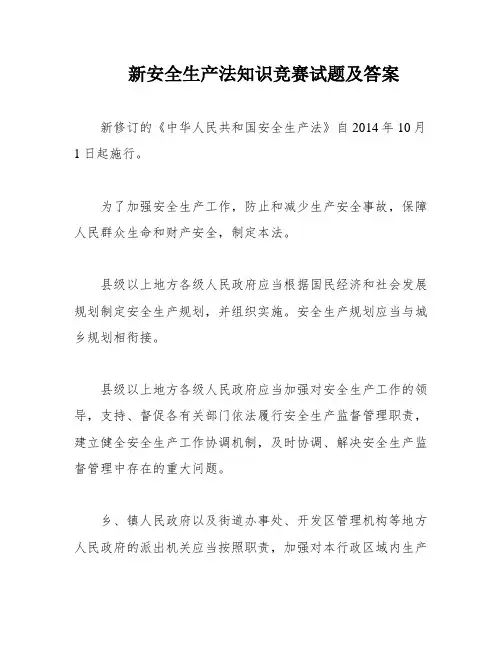
新安全生产法知识竞赛试题及答案新修订的《中华人民共和国安全生产法》自2014年10月1日起施行。
为了加强安全生产工作,防止和减少生产安全事故,保障人民群众生命和财产安全,制定本法。
县级以上地方各级人民政府应当根据国民经济和社会发展规划制定安全生产规划,并组织实施。
安全生产规划应当与城乡规划相衔接。
县级以上地方各级人民政府应当加强对安全生产工作的领导,支持、督促各有关部门依法履行安全生产监督管理职责,建立健全安全生产工作协调机制,及时协调、解决安全生产监督管理中存在的重大问题。
乡、镇人民政府以及街道办事处、开发区管理机构等地方人民政府的派出机关应当按照职责,加强对本行政区域内生产经营单位安全生产状况的监督检查,协助上级人民政府有关部门依法履行安全生产监督管理职责。
6.各级人民政府及其有关部门应采取多种形式加强对安全生产法律、法规和知识的宣传,提高全社会的安全生产意识。
7.负责安全生产监督管理的部门应建立健全重大事故隐患督办制度,督促生产经营单位消除重大事故隐患。
8.生产经营单位应按照规定将本单位重大危险源和有关安全措施、应急措施报备有关地方政府负责安全生产监督管理的部门备案。
9.根据本地区的安全生产情况,县级以上地方政府应组织有关部门对易发生重大生产安全事故的生产经营单位进行严格检查。
10.负责安全生产监督管理的部门在采取停止供电措施前,应提前二十四小时通知生产经营单位,除紧急情况外。
11.生产经营单位的从业人员有依法获得安全生产保障的权利,并应依法履行安全生产方面的义务。
12.生产经营单位必须执行制定的保障安全生产的国家标准或行业标准。
13.生产经营单位应保证安全生产所必需的资金投入,并对因资金不足导致的后果承担责任。
14.生产经营单位应按规定提取和使用安全生产费用,用于改善安全生产条件,并在成本中据实列支。
15.生产经营单位应建立安全生产教育和培训档案,记录教育和培训的时间、内容、参与人员和考核结果。
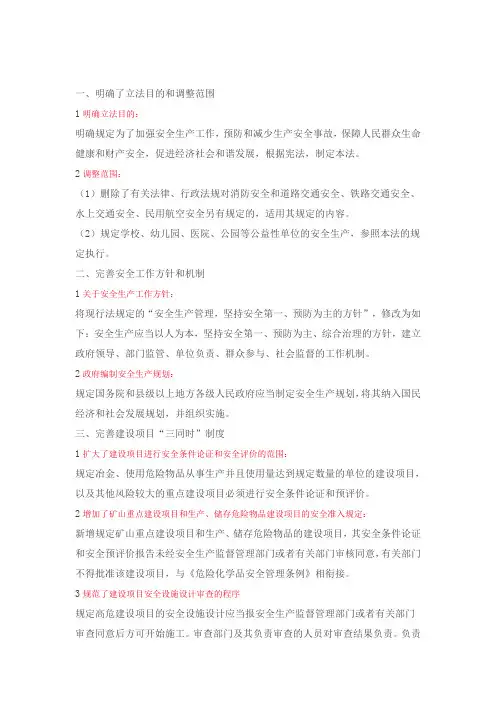
一、明确了立法目的和调整范围1明确立法目的:明确规定为了加强安全生产工作,预防和减少生产安全事故,保障人民群众生命健康和财产安全,促进经济社会和谐发展,根据宪法,制定本法。
2调整范围:(1)删除了有关法律、行政法规对消防安全和道路交通安全、铁路交通安全、水上交通安全、民用航空安全另有规定的,适用其规定的内容。
(2)规定学校、幼儿园、医院、公园等公益性单位的安全生产,参照本法的规定执行。
二、完善安全工作方针和机制1关于安全生产工作方针:将现行法规定的“安全生产管理,坚持安全第一、预防为主的方针”,修改为如下:安全生产应当以人为本,坚持安全第一、预防为主、综合治理的方针,建立政府领导、部门监管、单位负责、群众参与、社会监督的工作机制。
2政府编制安全生产规划:规定国务院和县级以上地方各级人民政府应当制定安全生产规划,将其纳入国民经济和社会发展规划,并组织实施。
三、完善建设项目“三同时”制度1扩大了建设项目进行安全条件论证和安全评价的范围:规定冶金、使用危险物品从事生产并且使用量达到规定数量的单位的建设项目,以及其他风险较大的重点建设项目必须进行安全条件论证和预评价。
2增加了矿山重点建设项目和生产、储存危险物品建设项目的安全准入规定:新增规定矿山重点建设项目和生产、储存危险物品的建设项目,其安全条件论证和安全预评价报告未经安全生产监督管理部门或者有关部门审核同意,有关部门不得批准该建设项目,与《危险化学品安全管理条例》相衔接。
3规范了建设项目安全设施设计审查的程序规定高危建设项目的安全设施设计应当报安全生产监督管理部门或者有关部门审查同意后方可开始施工。
审查部门及其负责审查的人员对审查结果负责。
负责审查的安全生产监督管理部门或者有关部门应当自收到安全设施设计后四十五日内作出审查意见书,并书面通知建设单位。
审查不得收取任何费用。
安全风险较大的建设项目的安全设施设计应当报安全生产监督管理部门或者有关部门备案,安全生产监督管理部门或者有关部门应当进行抽查。
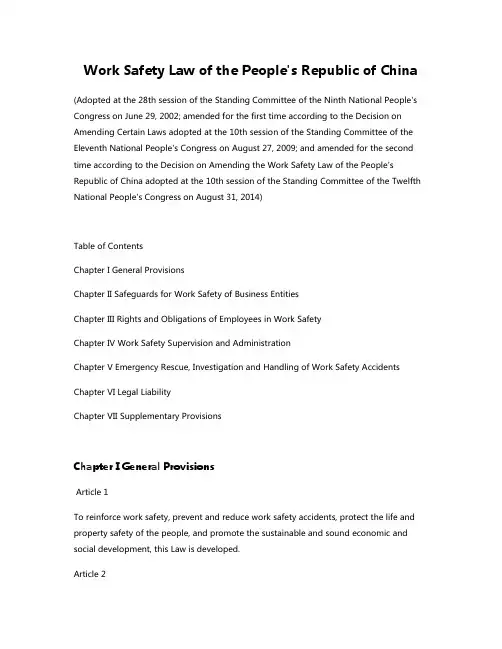
Work Safety Law of the People's Republic of China(Adopted at the 28th session of the Standing Committee of the Ninth National People's Congress on June 29, 2002; amended for the first time according to the Decision on Amending Certain Laws adopted at the 10th session of the Standing Committee of the Eleventh National People's Congress on August 27, 2009; and amended for the second time according to the Decision on Amending the Work Safety Law of the People's Republic of China adopted at the 10th session of the Standing Committee of the Twelfth National People's Congress on August 31, 2014)Table of ContentsChapter I General ProvisionsChapter II Safeguards for Work Safety of Business EntitiesChapter III Rights and Obligations of Employees in Work SafetyChapter IV Work Safety Supervision and AdministrationChapter V Emergency Rescue, Investigation and Handling of Work Safety Accidents Chapter VI Legal LiabilityChapter VII Supplementary ProvisionsChapter I General ProvisionsArticle 1To reinforce work safety, prevent and reduce work safety accidents, protect the life and property safety of the people, and promote the sustainable and sound economic and social development, this Law is developed.Article 2This Law is applicable to the work safety of entities engaged in production and other business activities (hereinafter referred to as the “business entities”) within the territory of the People's Republic of China. Where a relevant law or administrative regulation provides otherwise for fire safety, road traffic safety, railway traffic safety, waterway traffic safety, civil aviation safety, nuclear and radiation safety, or safety of special equipment, the provisions of such a law or administrative regulation shall apply.Article 3In work safety, the notion of “people-oriented and safe development” and the principle of “safety first, focusing on prevention, and integrated control” shall be adhered to, the primary responsibilities of business entities shall be reinforced and enforced, and a mechanism including the responsibilities of business entities, participation of employees, governmental regulation, industry self-regulation, and supervision from the general public shall be established.Article 4Business entities must comply with this Law and other laws and regulations related to work safety, strengthen work safety management, establish and improve their work safety responsibility systems and work safety polices and rules, enhance work safety conditions, promote work safety standardization, improve their work safety levels, and ensure work safety.Article 5The primary person in charge of a business entity shall be fully responsible for the business entity's work safety.Article 6Employees of a business entity shall be entitled to safeguards for work safety according to the law, and perform work safety obligations according to the law.Article 7Trade unions shall oversee work safety.The trade union of a business entity shall organize employees to participate in the democratic management and oversight of work safety of the business entity, and protect the lawful rights and interests of employees in terms of work safety. To develop or amend polices and rules related to work safety, a business entity shall hear the opinions of its trade union.Article 8The State Council and the local people's governments at and above the county level shall develop and organize the implementation of general plans on work safety in accordance with the national economic and social development plans. General plans on work safety shall be connected with general plans on urban and rural development.The State Council and the local people's governments at and above the county level shall strengthen their leadership in work safety, support and supervise the relevant departments in performing their regulatory duties in work safety according to the law, establish and improve work safety coordination mechanisms, and provide timely coordination and solutions to the major issues existing in work safety supervision and administration.The people's governments of townships and towns and the branch offices of the local people's governments such as sub-district offices and development zone management institutions shall, according to their duties, strengthen the supervisory inspection on work safety of business entities within their respective administrative regions, and assist the relevant departments of the people's governments at a higher level in performing their regulatory duties in work safety according to the law.Article 9The work safety administrative department of the State Council shall conduct comprehensive supervision and administration of work safety nationwide in accordance with this Law; and the work safety administrative departments of the local people's governments at and above the county level shall conduct comprehensive supervision and administration of work safety within their respective administrative regions in accordance with this Law.The relevant departments of the State Council shall, in accordance with this Law and other relevant laws and administrative regulations, conduct supervision and administration of work safety in the relevant sectors or fields within their respective scopes of duties; and the relevant departments of the local people's governments at and above the county level shall, in accordance with this Law and other relevant laws and regulations, conduct supervision and administration of work safety in the relevant sectors or fields within their respective scopes of duties.The work safety administrative departments and the departments conducting supervision and administration of work safety in the relevant sectors or fields are collectively referred to as the departments with work safety regulatory functions.Article 10The relevant departments of the State Council shall, according to the requirements for safeguarding work safety, develop relevant national or industry standards in a timely manner according to the law, and amend such standards appropriately on the basis of technological advancement and economic development.Business entities must implement the national or industry standards for safeguarding work safety developed according to the law.Article 11The people's governments at all levels and the relevant departments thereof shall strengthen the publicity of laws and regulations on work safety and work safety knowledge in various forms to raise the work safety awareness of the whole society.Article 12The relevant associations shall, in accordance with laws, administrative regulations, and their articles of association, provide business entities with information, training, and other services related to work safety, play their self-regulatory roles, and promote the enhanced work safety management of business entities.Article 13Institutions legally formed to provide work safety technical and management services shall, in accordance with laws, administrative regulations, and standards of practice, provide work safety technical and management services for business entities as agreed upon therewith.Where a business entity employs an aforesaid institution to provide work safety technical or management services, the business entity shall remain responsible for ensuring its work safety.Article 14The state shall apply an accountability enforcement system to work safety accidents, and the persons liable for such accidents shall be subject to legal liability in accordance with this Law and other relevant laws and regulations.Article 15The state shall encourage and support the scientific and technological research on work safety and the promotion and application of advanced work safety technology to improve the level of work safety.Article 16The state shall confer awards on entities and individuals which have made outstanding achievements in improving work safety conditions, preventing work safety accidents, and participating in rescue operations, among others.Chapter II Safeguards for Work Safety of Business EntitiesArticle 17Business entities shall meet the work safety conditions prescribed by this Law and other relevant laws, administrative regulations, and national or industry standards. Business entities not meeting such conditions shall not be engaged in production and other business activities.Article 18The primary person in charge of a business entity shall have the following duties in the work safety of the business entity:(1) Establishing and improving the work safety responsibility system of the business entity.(2) Organizing the development of policies, rules, and operating procedures for work safety of the business entity.(3) Organizing the development and implementation of the work safety education and training plans of the business entity.(4) Ensuring the effective utilization of the work safety input of the business entity.(5) Supervising and inspecting the work safety of the business entity to eliminate hidden risks of work safety accidents in a timely manner.(6) Organizing the preparation and implementation of the business entity's emergency rescue plans for work safety accidents.(7) Reporting work safety accidents in a timely and honest manner.Article 19The work safety responsibility system of a business entity shall specify the responsible person for each position, the scope of duties, and the evaluation criteria, among others.A business entity shall establish corresponding mechanisms to strengthen the supervision and evaluation of the implementation of its work safety responsibility system and ensure the implementation of the system.Article 20Input of funds necessary for a business entity to meet the prescribed work safety conditions shall be guaranteed by the decision-making body or the primary person in charge of the business entity or the self-employed investor of the business entity, and such a body, person in charge, or investor shall be liable for the consequences of insufficient input of funds necessary for work safety.The business entity shall, as legally required, set aside and use work safety expenses exclusively for improving work safety conditions. The actual amount of work safety expenses shall be included in costs. The specific measures for the set-aside, use, supervision, and administration of work safety expenses shall be developed by the financial department of the State Council in conjunction with the work safety administrative department of the State Council after solicitation of the opinions of other relevant departments of the State Council.Article 21An entity engaged in mining, metal smelting, building construction, or road transportation or an entity manufacturing, marketing, or storing hazardous substances shall establish a work safety management body or have full-time work safety management personnel.Any business entity other than those specified in the preceding paragraph shall establish a work safety management body or have full-time work safety management personnel if the number of its employees exceeds 100; or shall have full-time or part-time work safety management personnel if the number of its employees is 100 or less.Article 22The work safety management body and work safety management personnel of a business entity shall perform the following duties:(1) Organizing or participating in the development of the work safety policies, rules and operating procedures and the emergency rescue plans for work safety accidents of the business entity.(2) Organizing or participating in and honestly recording the work safety education and training of the business entity.(3) Supervising the implementation of safety control measures for the major hazard installations of the business entity.(4) Organizing or participating in the emergency rescue rehearsals of the business entity.(5) Inspecting the work safety condition of the business entity, conducting screening for any hidden risks of work safety accidents in a timely manner, and offering recommendations for improving work safety management.(6) Prohibiting and redressing any command against rules, forced operation at risk, or violation of the operating procedures.(7) Supervising the work safety corrective actions taken by the business entity.Article 23The work safety management body and work safety management personnel of a business entity shall faithfully and legally perform their duties.In making work safety-related business decisions, a business entity shall hear the opinions of its work safety management body and work safety management personnel.A business entity may not lower the wages, welfare, and other remuneration of or rescinds the employment contract with a work safety management employee because of the employee's performance of duties according to the law.An entity manufacturing or storing hazardous substances or engaged in mining or metal smelting shall inform the competent department with work safety regulatory functions of any appointment or removal of work safety management personnel.Article 24The primary person in charge and the work safety management personnel of a business entity must have work safety knowledge and management capabilities commensurate with the business activities of the business entity.The primary person in charge and the work safety management personnel of an entity manufacturing, marketing, or storing hazardous substances or an entity engaged in mining, metal smelting, building construction, or road transportation shall pass the assessment on their work safety knowledge and management capabilities conducted by the competent department with work safety regulatory functions. No fees shall be charged for such assessment.An entity manufacturing or storing hazardous substances or an entity engaged in mining or metal smelting shall employ certified safety engineers to conduct work safety management. Other business entities shall be encouraged to employ certified safety engineers to conduct work safety management. Certified safety engineers shall be subject to categorized management by specialty, and the specific measures for the management thereof shall be developed by the human resources and social security department of the State Council and the work safety administrative department of the State Council in conjunction other relevant departments of the State Council.Article 25Business entities shall provide their employees with work safety education and training to ensure that their employees have necessary work safety knowledge, are familiar with the relevant work safety policies and rules and safe operating procedures, possess the safe operating skills for their respective posts, know the emergency response measures for accidents, and are informed of their rights and obligations in work safety. Employees failing the work safety education and training shall not take their posts.A business entity using seconded workers shall include seconded workers in its own employees for unified management, and provide seconded workers with education and training on safe operating procedures and safe operating skills for the relevant posts. The supplier of seconded workers shall provide necessary work safety education and training for them.A business entity receiving interns from secondary vocational schools or institutions of higher education shall provide corresponding work safety education and training for interns, and provide necessary labor protection products. The schools shall assist the business entity in providing work safety education and training for interns.A business entity shall maintain work safety education and training files to honestly record the time, contents, participants, and evaluation results, among others, of work safety education and training.Article 26To use any new technique, technology, material or equipment, a business entity must study and understand its safety technical features, adopt effective safety protection measures, and provide their employees with special education and training on work safety.Article 27Special operation workers of a business entity must receive special training on safe operation as required by the state, and may take their posts only after obtaining a corresponding qualification.The scope of special operation workers shall be determined by the work safety administrative department of the State Council in conjunction with the other relevant departments of the State Council.Article 28The safety facilities in a new construction, reconstruction, or expansion project of a business entity (hereinafter refers to as the “construction project”) must be designed, constructed, and put to use in production and other operations simultaneously with the body of the project. Input for the safety facilities shall be included in the budgetary estimate of the construction project.Article 29Mining and metal smelting construction projects and construction projects for the manufacturing, storage, or loading and unloading of hazardous substances shall be subject to safety assessment according to the relevant provisions of the state.Article 30The designers and designing entities of the safety facilities in construction projects shall be responsible for the design of the safety facilities.The designs of safety facilities in mining and metal smelting construction projects and construction projects for the manufacturing, storage, or loading and unloading of hazardous substances shall be submitted to the relevant departments for examinationaccording to the relevant provisions of the state. The examination departments and their examiners shall be responsible for the results of examination.Article 31The construction entity of a mining or metal smelting construction project or a construction project for the manufacturing, storage, or loading and unloading of hazardous substances must adhere to the approved design of safety facilities, and be responsible for the engineering quality of safety facilities.Before a completed mining or metal smelting construction project or a completed construction project for the manufacturing or storage of hazardous substances starts production or is put to use, the construction employer shall organize an acceptance check of safety facilities; and it may start production or be put to use only after the safety facilities pass the acceptance check. The work safety administrative department shall strengthen the supervision and inspection of the acceptance check activities of construction employers and the results of acceptance check.Article 32Business entities shall set conspicuous safety signs on business premises and relevant facilities and equipment with greater risk factors.Article 33Safety equipment shall be designed, manufactured, installed, used, tested, maintained, improved, and retired in accordance with national or industry standards.Business entities must conduct routine repair and maintenance and regular testing of their safety equipment to ensure its normal operation. Records of repair, maintenance, and testing shall be properly made and signed by the relevant personnel.Article 34The containers or transport vehicles for hazardous substances and the life-threatening or substantially dangerous special equipment for offshore oil exploitation or underground mining, as used by business entities, must be manufactured by specialized manufacturers,and may be put to use only after passing the tests and inspections conducted by professionally qualified testing and inspection institutions and obtaining the safe use certificates or safety labels. The testing and inspection institutions shall be responsible for the test and inspection results.Article 35The state shall apply an elimination system to techniques and equipment seriously threatening work safety, and the specific catalogue thereof shall be developed and published by the work safety administrative department of the State Council in conjunction with other relevant departments of the State Council. Where any law or administrative regulation provides otherwise for the development of such catalogues, the provisions of such a law or administrative regulation shall apply.The people's government of a province, autonomous region, or municipality directly under the Central Government may, according to the specific local circumstances, develop and publish a specific catalogue to eliminate techniques and equipment threatening work safety other than those as mentioned in the preceding paragraph.No business entity may use any technique or equipment which threatens work safety and shall be eliminated.Article 36The manufacturing, marketing, transportation, storage, and use of hazardous substances or the disposal of hazardous waste shall be subject to the approval, supervision and administration of the competent authorities in accordance with relevant laws and regulations and national or industry standards.To manufacture, market, transport, store, or use hazardous substances or dispose of hazardous waste, business entities must comply with relevant laws and regulations and national or industry standards, establish a special safety management system, adopt reliable safety measures, and be subject to the supervision and administration of the competent authorities according to the law.Article 37Business entities shall register and maintain files for major hazard installations, conduct regular monitoring, assessment and control, prepare emergency response plans, and inform employees and relevant personnel of measures to be taken in case of emergency.A business entity shall, according to the relevant provisions of the state, report its major hazard installments and related safety measures and emergency response measures to the work safety administrative department and other relevant departments of the local people's government for recordation.Article 38A business entity shall establish and improve rules for the screening for and elimination of hidden risks of work safety accidents, and take technical and management measures to discover and eliminate such hidden risks in a timely manner. It shall honestly record, and inform its employees of, the screening and elimination.The departments with work safety regulatory functions of the local people's governments at and above the county level shall establish and improve rules for supervising the elimination of hidden risks of serious accidents to impel business entities to eliminate such risks.Article 39Workshops, shops, or warehouses for the manufacturing, marketing, storage, or use of hazardous substances shall not share the same building with employee dormitories, and a safe distance shall be maintained between them and employee dormitories.Business premises and employee dormitories shall have free exits with clear signs meeting the emergency evacuation requirements. Exits of business premises and employee dormitories shall not be locked or sealed.Article 40To conduct blasting, hoisting, or any other dangerous operation as specified by the work safety administrative department of the State Council in conjunction with other relevant departments of the State Council, a business entity shall arrange for special personnel toconduct on-site safety management, ensuring its compliance with operating procedures and implementation of safety measures.Article 41A business entity shall educate and supervise its employees on strictly complying with its work safety rules and operating procedures, and honestly inform its employees of the risk factors existing at their work sites and posts, the preventative measures, and the measures to be taken in case of emergency.Article 42Business entities must provide their employees with labor protection products meeting the national or industry standards, and supervise and educate their employees on wearing or using such products in accordance with the rules of use.Article 43The work safety management personnel of a business entity shall conduct routine inspections on work safety according to the characteristics of production and other operations of the business entity, immediately address safety issues discovered in such inspections, and report safety issues that they are unable to address to the relevant person in charge of the business entity in a timely manner, who shall address such issues in a timely manner. A record of such inspections and issues addressed shall be honestly maintained.The work safety management personnel of the business entity shall report any major potential accident detected in the inspections to the relevant person in charge of the business entity according to the preceding paragraph; if such relevant person in charge of the business entity is unable to address in a timely manner, the work safety management personnel may report to the departments with work safety regulatory functions, which shall address such hazard in a timely manner according to law.Article 44Production and business units shall arrange funds for the provision of work protection gears and for training in work safety.Article 45Where two or more production and business units are conducting production and business activities in the same work zone, which presents potential dangers to each other's work safety, they shall sign on agreement on work safety control, in which the responsibilities of each party for work safety control shall be defined and the safety measures to be taken by each party shall be made clear. In addition, each party shall assign full-time persons for control over work safety to conduct safety inspection and coordination.Article 46No production or business units may contract out or lease production or business projects, work places or equipment to any units or individuals that do not possess the conditions for work safety or the necessary qualifications.In case a production and business operation project or site is contracted or leased to other entities, the business entity shall enter into special agreement with the contractor or leaseholder concerning the administration of work safety, or stipulate in the contracting agreements or leasehold contract the duties and functions of each party in the administration of work safety; the business entity shall apply unified coordination and administration over the contractors and leaseholders concerning the work of work safety, and conduct safety inspection on a regular basis and urge timely correction of safety issues if noticed in the regular safety inspection.Article 47When a major accident due to neglect of work safety occurs in a production or business unit, the principal leading member of the unit shall immediately make arrangements for rescue operation; and, during the period of investigation and handling of the accident, he may not leave his post without permission.Article 48Production and business entities shall, in accordance with law, purchase work-related injury insurance and pay insurance premiums for their employees.Chapter III Rights and Obligations of Employees in Work SafetyArticle 49In the labour contracts signed between production and business units and their employees shall be clearly indicated the items concerning guarantees for occupational safety of the employees, prevention of occupational hazards, as well as the item concerning payment, according to law, of insurance premiums for work-related injuries suffered by employees.No production or business units may, in any form, conclude agreements with their employees in an attempt to relieve themselves of, or lighten, the responsibilities they should bear in accordance with law for the employees who are injured or killed in accidents which occur due to lack of work safety.Article 50Employees of production and business units shall have the right to the knowledge of the dangerous factors existing at their work places and posts, and of the precaution and exigency measures, and they shall have the right to put forward suggestions on work safety of the units where they work.Article 51Employees shall have the right to criticize, inform against and accuse their work units for the problems existing in work safety. They shall have the right to refuse to comply with the directions that are contrary to rules and regulations or arbitrary orders for risky operations.No production and business units may reduce the wages or welfare standards of, or cancel the labour contracts concluded with, the employees because the latter criticize, inform against, accuse or refuse to comply with the directions that are contrary to rules and regulations or arbitrary orders for risky operations.Article 52。
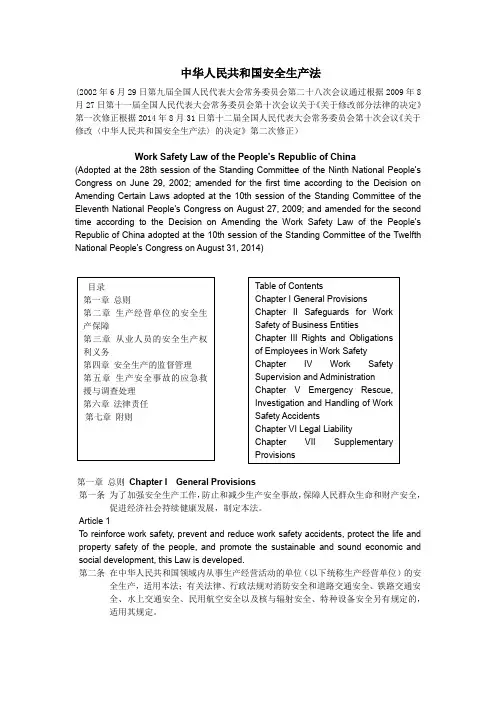
中华人民共和国安全生产法(2002年6月29日第九届全国人民代表大会常务委员会第二十八次会议通过根据2009年8月27日第十一届全国人民代表大会常务委员会第十次会议关于《关于修改部分法律的决定》第一次修正根据2014年8月31日第十二届全国人民代表大会常务委员会第十次会议《关于修改〈中华人民共和国安全生产法〉的决定》第二次修正)Work Safety Law of the People's Republic of China(Adopted at the 28th session of the Standing Committee of the Ninth National People's Congress on June 29, 2002; amended for the first time according to the Decision on Amending Certain Laws adopted at the 10th session of the Standing Committee of the Eleventh National People's Congress on August 27, 2009; and amended for the second time according to the Decision on Amending the Work Safety Law of the People's Republic of China adopted at the 10th session of the Standing Committee of the Twelfth National People's Congress on August 31, 2014)第一章总则Chapter I General Provisions第一条为了加强安全生产工作,防止和减少生产安全事故,保障人民群众生命和财产安全,促进经济社会持续健康发展,制定本法。
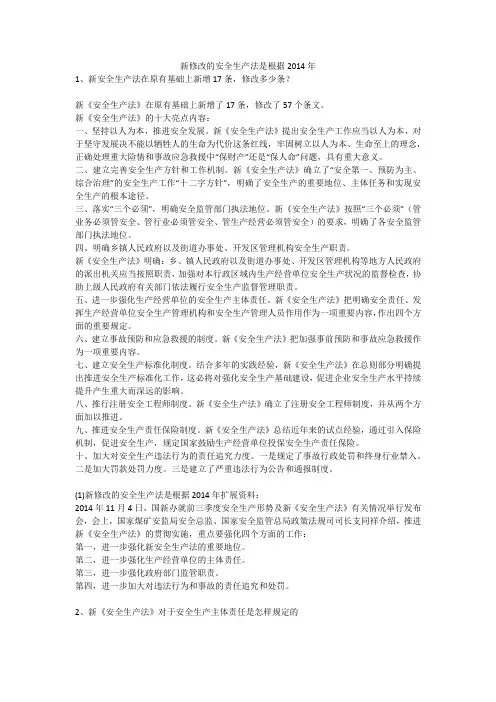
新修改的安全生产法是根据2014年1、新安全生产法在原有基础上新增17条,修改多少条?新《安全生产法》在原有基础上新增了17条,修改了57个条文。
新《安全生产法》的十大亮点内容:一、坚持以人为本,推进安全发展。
新《安全生产法》提出安全生产工作应当以人为本,对于坚守发展决不能以牺牲人的生命为代价这条红线,牢固树立以人为本、生命至上的理念,正确处理重大险情和事故应急救援中“保财产”还是“保人命”问题,具有重大意义。
二、建立完善安全生产方针和工作机制。
新《安全生产法》确立了“安全第一、预防为主、综合治理”的安全生产工作“十二字方针”,明确了安全生产的重要地位、主体任务和实现安全生产的根本途径。
三、落实“三个必须”,明确安全监管部门执法地位。
新《安全生产法》按照“三个必须”(管业务必须管安全、管行业必须管安全、管生产经营必须管安全)的要求,明确了各安全监管部门执法地位。
四、明确乡镇人民政府以及街道办事处、开发区管理机构安全生产职责。
新《安全生产法》明确:乡、镇人民政府以及街道办事处、开发区管理机构等地方人民政府的派出机关应当按照职责,加强对本行政区域内生产经营单位安全生产状况的监督检查,协助上级人民政府有关部门依法履行安全生产监督管理职责。
五、进一步强化生产经营单位的安全生产主体责任。
新《安全生产法》把明确安全责任、发挥生产经营单位安全生产管理机构和安全生产管理人员作用作为一项重要内容,作出四个方面的重要规定。
六、建立事故预防和应急救援的制度。
新《安全生产法》把加强事前预防和事故应急救援作为一项重要内容。
七、建立安全生产标准化制度。
结合多年的实践经验,新《安全生产法》在总则部分明确提出推进安全生产标准化工作,这必将对强化安全生产基础建设,促进企业安全生产水平持续提升产生重大而深远的影响。
八、推行注册安全工程师制度。
新《安全生产法》确立了注册安全工程师制度,并从两个方面加以推进。
九、推进安全生产责任保险制度。
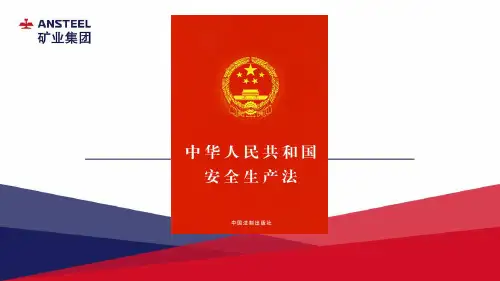
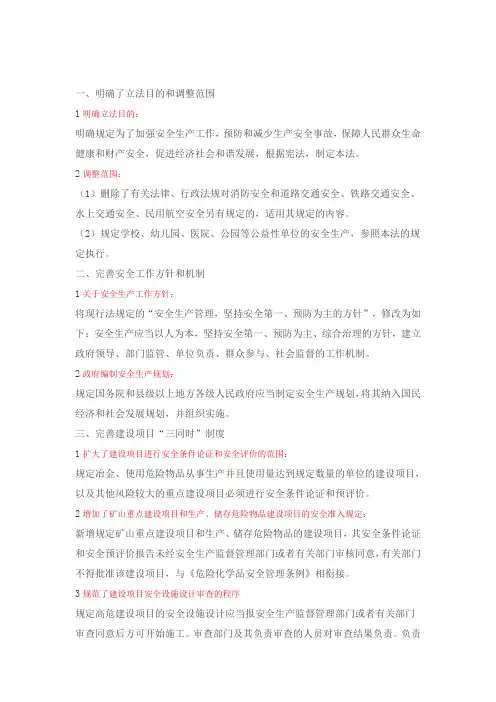
一、明确了立法目的和调整范围1明确立法目的:明确规定为了加强安全生产工作,预防和减少生产安全事故,保障人民群众生命健康和财产安全,促进经济社会和谐发展,根据宪法,制定本法。
2调整范围:(1)删除了有关法律、行政法规对消防安全和道路交通安全、铁路交通安全、水上交通安全、民用航空安全另有规定的,适用其规定的内容。
(2)规定学校、幼儿园、医院、公园等公益性单位的安全生产,参照本法的规定执行。
二、完善安全工作方针和机制1关于安全生产工作方针:将现行法规定的“安全生产管理,坚持安全第一、预防为主的方针”,修改为如下:安全生产应当以人为本,坚持安全第一、预防为主、综合治理的方针,建立政府领导、部门监管、单位负责、群众参与、社会监督的工作机制。
2政府编制安全生产规划:规定国务院和县级以上地方各级人民政府应当制定安全生产规划,将其纳入国民经济和社会发展规划,并组织实施。
三、完善建设项目“三同时”制度1扩大了建设项目进行安全条件论证和安全评价的范围:规定冶金、使用危险物品从事生产并且使用量达到规定数量的单位的建设项目,以及其他风险较大的重点建设项目必须进行安全条件论证和预评价。
2增加了矿山重点建设项目和生产、储存危险物品建设项目的安全准入规定:新增规定矿山重点建设项目和生产、储存危险物品的建设项目,其安全条件论证和安全预评价报告未经安全生产监督管理部门或者有关部门审核同意,有关部门不得批准该建设项目,与《危险化学品安全管理条例》相衔接。
3规范了建设项目安全设施设计审查的程序规定高危建设项目的安全设施设计应当报安全生产监督管理部门或者有关部门审查同意后方可开始施工。
审查部门及其负责审查的人员对审查结果负责。
负责审查的安全生产监督管理部门或者有关部门应当自收到安全设施设计后四十五日内作出审查意见书,并书面通知建设单位。
审查不得收取任何费用。
安全风险较大的建设项目的安全设施设计应当报安全生产监督管理部门或者有关部门备案,安全生产监督管理部门或者有关部门应当进行抽查。
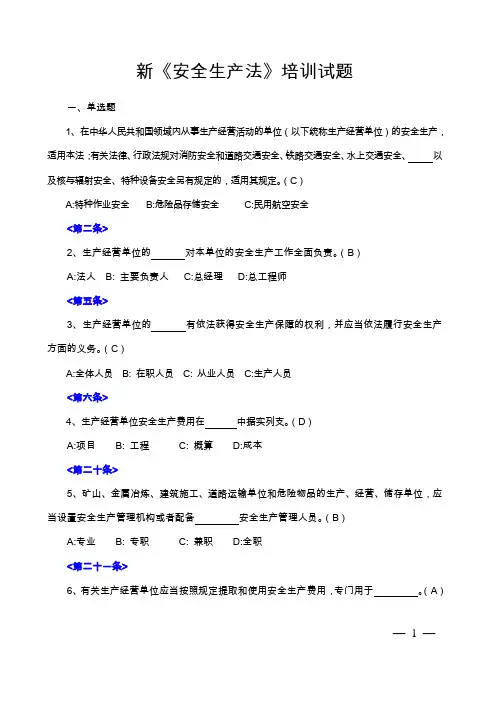
新《安全生产法》培训试题一、单选题1、在中华人民共和国领域内从事生产经营活动的单位(以下统称生产经营单位)的安全生产,及核与辐射安全、特种设备安全另有规定的,适用其规定。
(C)A:特种作业安全B:危险品存储安全C:民用航空安全<第二条>A:法人B: 主要负责人C:总经理D:总工程师<第五条>方面的义务。
(C)A:全体人员B: 在职人员C: 从业人员C:生产人员<第六条>4、生产经营单位安全生产费用在中据实列支。
(D)A:项目B: 工程C: 概算D:成本<第二十条>5、矿山、金属冶炼、建筑施工、道路运输单位和危险物品的生产、经营、储存单位,应当设置安全生产管理机构或者配备安全生产管理人员。
(B)A:专业B: 专职C: 兼职D:全职<第二十一条>—1 —— 2 — A: 改善安全生产条件 B: 保证安全组织措施C: 保证安全文明施工 D :购置安全工器具<第二十条>7、生产经营单位应当对从业人员进行安全生产教育和培训,保证从业人员具备必要的安处理措施,知悉自身在安全生产方面的权利和义务。
(C )A:相关操作流程 B: 安全的组织措施和技术措施C:本岗位的安全操作技能 D: 标准化操作手册<第二十五条>8、矿山、金属冶炼建设项目和用于生产、储存、装卸危险物品的建设项目,应当按照国家有关规定进行 。
(B )A:安全论证 B: 安全评价 C: 安全检查 D: 安全考核<第二十九条>9、矿山、金属冶炼建设项目和用于生产、储存危险物品的建设项目竣工投入生产或者使用前,应A:施工 B: 监理 C: 建设 D:设计<第三十一条>置明显的安全警示标志。
(B )A:一般 B: 较大 C: 重大 D: 特大<第三十二条>11、生产经营单位对 危险源应当登记建档,进行定期检测、评估、监控,并制定应急预案,告知从业人员和相关人员在紧急情况下应当采取的应急措施。
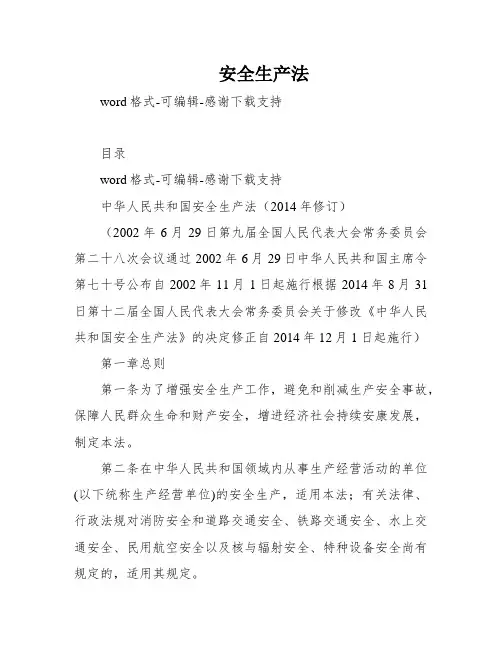
安全生产法word格式-可编辑-感谢下载支持目录word格式-可编辑-感谢下载支持中华人民共和国安全生产法(2014年修订)(2002年6月29日第九届全国人民代表大会常务委员会第二十八次会议通过2002年6月29日中华人民共和国主席令第七十号公布自2002年11月1日起施行根据2014年8月31日第十二届全国人民代表大会常务委员会关于修改《中华人民共和国安全生产法》的决定修正自2014年12月1日起施行)第一章总则第一条为了增强安全生产工作,避免和削减生产安全事故,保障人民群众生命和财产安全,增进经济社会持续安康发展,制定本法。
第二条在中华人民共和国领域内从事生产经营活动的单位(以下统称生产经营单位)的安全生产,适用本法;有关法律、行政法规对消防安全和道路交通安全、铁路交通安全、水上交通安全、民用航空安全以及核与辐射安全、特种设备安全尚有规定的,适用其规定。
第三条安全生产工作应当以人为本,坚持安全发展,坚持安全第一、预防为主、综合治理的方针,强化和落实生产经营单位的主体任务,建立生产经营单位负责、职工参与、政府监管、行业自律和社会监督的机制。
第四条生产经营单位必须遵守本法和其他有关安全生产的法律、法规,加强安全生产管理,建立、健全安全生产责任制和安全生word格式-可编纂-感激下载支持产规章制度,改善安全生产条件,推进安全生产标准化建设,提高安全生产水平,确保安全生产。
第五条生产经营单位的主要负责人对本单位的安全生产工作全面负责。
第六条生产经营单位的从业职员有依法获得安全生产保障的权力,并应当依法履行安全生产方面的任务。
第七条工会依法对安全生产工作进行监督。
生产经营单位的工会依法组织职工参加本单位安全生产工作的民主管理和民主监督,维护职工在安全生产方面的合法权益。
生产经营单位制定或者修改有关安全生产的规章制度,应当听取工会的意见。
第八条国务院和县级以上地方各级人民政府应当根据国民经济和社会发展规划制定安全生产规划,并组织实施。
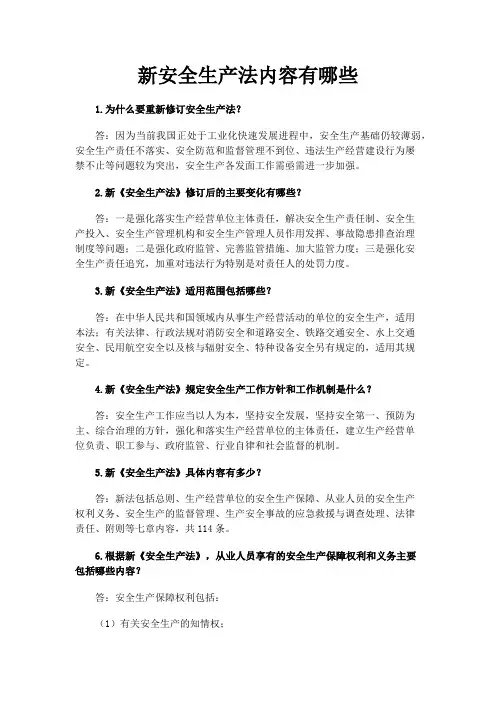
新安全生产法内容有哪些1.为什么要重新修订安全生产法?答:因为当前我国正处于工业化快速发展进程中,安全生产基础仍较薄弱,安全生产责任不落实、安全防范和监督管理不到位、违法生产经营建设行为屡禁不止等问题较为突出,安全生产各发面工作需亟需进一步加强。
2.新《安全生产法》修订后的主要变化有哪些?答:一是强化落实生产经营单位主体责任,解决安全生产责任制、安全生产投入、安全生产管理机构和安全生产管理人员作用发挥、事故隐患排查治理制度等问题;二是强化政府监管、完善监管措施、加大监管力度;三是强化安全生产责任追究,加重对违法行为特别是对责任人的处罚力度。
3.新《安全生产法》适用范围包括哪些?答:在中华人民共和国领域内从事生产经营活动的单位的安全生产,适用本法;有关法律、行政法规对消防安全和道路安全、铁路交通安全、水上交通安全、民用航空安全以及核与辐射安全、特种设备安全另有规定的,适用其规定。
4.新《安全生产法》规定安全生产工作方针和工作机制是什么?答:安全生产工作应当以人为本,坚持安全发展,坚持安全第一、预防为主、综合治理的方针,强化和落实生产经营单位的主体责任,建立生产经营单位负责、职工参与、政府监管、行业自律和社会监督的机制。
5.新《安全生产法》具体内容有多少?答:新法包括总则、生产经营单位的安全生产保障、从业人员的安全生产权利义务、安全生产的监督管理、生产安全事故的应急救援与调查处理、法律责任、附则等七章内容,共114条。
6.根据新《安全生产法》,从业人员享有的安全生产保障权利和义务主要包括哪些内容?答:安全生产保障权利包括:(1)有关安全生产的知情权;(2)有获得符合国家标准的劳动防护用品的权利;(3)有对安全生产生产提出批评、建议的权利;(4)有对违章指挥的拒绝权;(5)有采取紧急避险措施的权利;(6)在发生生产安全事故后,有获得及时抢救和医疗救治并获得工伤保险赔付的权利等。
安全生产的义务有:(1)在作业过程中遵守本单位的安全生产规章制度和操作规程,服从管理,不得违章作业;(2)接受安全生产教育和培训,掌握本职工作所需要和安全生产知识;(3)发现事故隐患应当及时向本单位安全生产管理人员或主要负责人报告;(4)正确使用和佩戴劳动防护用品。
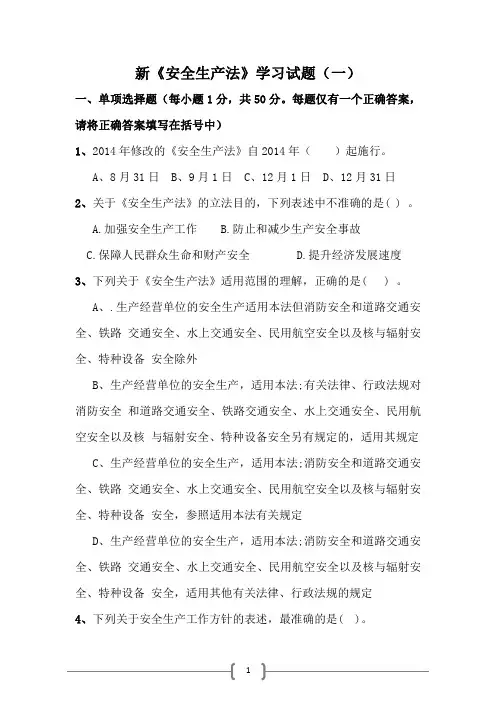
新《安全生产法》学习试题(一)一、单项选择题(每小题1分,共50分。
每题仅有一个正确答案,请将正确答案填写在括号中)1、2014年修改的《安全生产法》自2014年()起施行。
A、8月31日B、9月1日C、12月1日D、12月31日2、关于《安全生产法》的立法目的,下列表述中不准确的是( ) 。
A.加强安全生产工作B.防止和减少生产安全事故C.保障人民群众生命和财产安全D.提升经济发展速度3、下列关于《安全生产法》适用范围的理解,正确的是( ) 。
A、.生产经营单位的安全生产适用本法但消防安全和道路交通安全、铁路交通安全、水上交通安全、民用航空安全以及核与辐射安全、特种设备安全除外B、生产经营单位的安全生产,适用本法;有关法律、行政法规对消防安全和道路交通安全、铁路交通安全、水上交通安全、民用航空安全以及核与辐射安全、特种设备安全另有规定的,适用其规定C、生产经营单位的安全生产,适用本法;消防安全和道路交通安全、铁路交通安全、水上交通安全、民用航空安全以及核与辐射安全、特种设备安全,参照适用本法有关规定D、生产经营单位的安全生产,适用本法;消防安全和道路交通安全、铁路交通安全、水上交通安全、民用航空安全以及核与辐射安全、特种设备安全,适用其他有关法律、行政法规的规定4、下列关于安全生产工作方针的表述,最准确的是( )。
A、以人为本、安全第一、预防为主B、安全第一、预防为主、政府监管C、安全第一、预防为主、综合治理D、安全第一、预防为主、群防群治5、关于安全生产工作机制,不正确的表述是( )。
A、政府负责B、职工参与 c、行业自律 D、社会监督6、安全生产费用提取、使用和监督管理的具体办法由()会同国务院安全生产监督管理部门征求国务院有关部门意见后制定。
A、地方政府部门B、国务院财政部门C、发改委D、生产经营单位7、《安全生产法》规定,生产经营单位的主要负责人对本单位安全生产工作()。
A、全面负责B、负责监督检查C、负责日常检查D、负责指挥作业8、某公司董事长由上一级单位总经理张某兼任,张某长期在外地,不负责该公司日常工作。
一、明确了立法目的和调整范围1明确立法目的:明确规定为了加强安全生产工作,预防和减少生产安全事故,保障人民群众生命健康和财产安全,促进经济社会和谐发展,根据宪法,制定本法。
2调整范围:(1)删除了有关法律、行政法规对消防安全和道路交通安全、铁路交通安全、水上交通安全、民用航空安全另有规定的,适用其规定的内容。
(2)规定学校、幼儿园、医院、公园等公益性单位的安全生产,参照本法的规定执行。
二、完善安全工作方针和机制1关于安全生产工作方针:将现行法规定的“安全生产管理,坚持安全第一、预防为主的方针”,修改为如下:安全生产应当以人为本,坚持安全第一、预防为主、综合治理的方针,建立政府领导、部门监管、单位负责、群众参与、社会监督的工作机制。
2政府编制安全生产规划:规定国务院和县级以上地方各级人民政府应当制定安全生产规划,将其纳入国民经济和社会发展规划,并组织实施。
三、完善建设项目“三同时”制度1扩大了建设项目进行安全条件论证和安全评价的范围:规定冶金、使用危险物品从事生产并且使用量达到规定数量的单位的建设项目,以及其他风险较大的重点建设项目必须进行安全条件论证和预评价。
2增加了矿山重点建设项目和生产、储存危险物品建设项目的安全准入规定:新增规定矿山重点建设项目和生产、储存危险物品的建设项目,其安全条件论证和安全预评价报告未经安全生产监督管理部门或者有关部门审核同意,有关部门不得批准该建设项目,与《危险化学品安全管理条例》相衔接。
3规范了建设项目安全设施设计审查的程序规定高危建设项目的安全设施设计应当报安全生产监督管理部门或者有关部门审查同意后方可开始施工。
审查部门及其负责审查的人员对审查结果负责。
负责审查的安全生产监督管理部门或者有关部门应当自收到安全设施设计后四十五日内作出审查意见书,并书面通知建设单位。
审查不得收取任何费用。
安全风险较大的建设项目的安全设施设计应当报安全生产监督管理部门或者有关部门备案,安全生产监督管理部门或者有关部门应当进行抽查。
安全生产法修正时间1、安全生产法什么时候修改新修订的《安全生产法》,2014年12月1日开始实施。
复2014年8月31日,中华人民共和国第十二届全国制人民代表大会常务委员百会第十次会议研究通过《全国人民代表大会常务委员会关于修改度〈中华人民共和国安全生产法〉的决定》。
知根据中华人民共和国主席令第十三号,予以公布,并决定自2014年12月1日起施行。
道2、《中华人民共和国安全生产法》正式颁布实施的时间为哪年?《中华人民共和国安全生产法》正式颁布实施的时间为2002年6月29日通过,自2002年11月1日起施行。
由中华人民共和国第九届全国人民代表大会常务委员会第二十八次会议通过。
《中华人民共和国安全生产法》是为了加强安全生产工作,防止和减少生产安全事故,保障人民群众生命和财产安全,促进经济社会持续健康发展,制定本法。
(2)安全生产法修正时间扩展资料:《中华人民共和国安全生产法》内容:1.政府的职责(1)各级政府应当加强对安全生产工作的领导。
各级政府都要制定安全生产规划并纳入国民经济和社会发展的总体规划,认真研究解决本地区安全生产中的重大问题;要做到有法必依、执法必严、违法必究,确保有关法律、法和国家关于安全生产的方针政策的贯彻执行;要加强对事故预防工作的领导,按规定对危险性大、职业危害严重及重点项目的建设把好审批立项关,对威胁公众安全的重大事故隐患和危险设施、场所,要组织有关部门进行安全性评估,要落实整改责任单位,对不能立即消除的重大事故隐患,必须采取严密的防范措施并制定应急计划;要加强安全生产的宣传教育,努力提高广大人民群众遵章守纪的自觉性和安全生产意识等。
(2)各级政府应当支持、督促各有关部门依法履行安全生产监督管理职责。
县级以上各级政府对本级政府所属各有关部门依法履行安全生产监督管理的职责,负有领导和督促的责任;包括乡、镇政府在内的各级地方政府对上级政府有关部门对安全生产的监督管理,应当给予支持、配合。
新安全生产法1、新安全生产法一共多少章多少条新《安全生产法》共7章、114条,与原法相比增加17个条文、修改57个条文。
2014年1月15日,国务院常务会议审议并通过《安全生产法》修正案草案。
2月25日,全国人大常委会第一次审议修正案(草案)。
8月31日,全国人大常委会第二次审议表决通过,于2014年12月1日起正式施行。
新《安全生产法》的意义:1.确定了“安全第一,预防为主、综合治理”的工作方针,明确了安全生产的重要地位、主体任务和实现安全生产的根本途径;2.牢固了以人为本、生命至上的理念,坚守发展决不能以牺牲人的生命为代价这条“红线”,建立生产经营单位负责、职工参与、政府监管、行业自律、社会监督的机制,进一步明确了各方安全生产职责;3.进一步提升安全生产工作的重要地位、强化生产经营单位主题责任、加强政府监管、强化责任追究,预防和减少生产安全事故,保障人民群众生命和财产安全,促进经济社会持续健康发展具有重大意义;4.为推进依法治理、建立规范的安全生产法制依序提供了强大的法律武器,也为安全生产监督管理工作提供了法律支撑。
安全与生产是一对双胞胎,既相互矛盾,又相互统一。
没有生产,何谈安全;没有安全,生产何以为继。
再者,就生产安全事故的定义而论,不仅人的生命和生产经营单位的财产损失是事故,而且明确了造成生产经营活动暂时或永久停止也是事故。
从这个意义上讲,安全生产管理不仅要保障人民的生命财产安全,而且要把保障生产持续、稳定、健康、有序运行作为自身的根本任务和目的全面展开。
从而促进经济发展。
《安全生产法》作为我国安全生产的综合性法律,具有丰富的法律内涵和规范作用。
它的通过实施,对全面加强我国安全生产法制建设,激发全社会对公民生命权的珍视和保护,提高全民族的安全法律意识,规范生产经营单位的安全生产,强化安全生产监督管理,遏制重大、特大事故,促进经济发展和保持社会稳定都具有重大的现实意义,必将产生深远的历史影响。
中华人民共和国安全生产法(2014年修订)(2002年6月29日第九届全国人民代表大会常务委员会第二十八次会议通过根据2009年8月27日第十一届全国人民代表大会常务委员会第十次会议关于《关于修改部分法律的决定》第一次修正根据2014年8月31日第十二届全国人民代表大会常务委员会第十次会议《关于修改〈中华人民共和国安全生产法〉的决定》第二次修正) 目录第一章总则第二章生产经营单位的安全生产保障第三章从业人员的安全生产权利义务第四章安全生产的监督管理第五章生产安全事故的应急救援与调查处理第六章法律责任第七章附则第一章总则第一条为了加强安全生产工作,防止和减少生产安全事故,保障人民群众生命和财产安全,促进经济社会持续健康发展,制定本法。
第二条在中华人民共和国领域内从事生产经营活动的单位(以下统称生产经营单位)的安全生产,适用本法;有关法律、行政法规对消防安全和道路交通安全、铁路交通安全、水上交通安全、民用航空安全以及核与辐射安全、特种设备安全另有规定的,适用其规定。
第三条安全生产工作应当以人为本,坚持安全发展,坚持安全第一、预防为主、综合治理的方针,强化和落实生产经营单位的主体责任,建立生产经营单位负责、职工参与、政府监管、行业自律和社会监督的机制。
第四条生产经营单位必须遵守本法和其他有关安全生产的法律、法规,加强安全生产管理,建立、健全安全生产责任制和安全生产规章制度,改善安全生产条件,推进安全生产标准化建设,提高安全生产水平,确保安全生产。
第五条生产经营单位的主要负责人对本单位的安全生产工作全面负责。
第六条生产经营单位的从业人员有依法获得安全生产保障的权利,并应当依法履行安全生产方面的义务。
第七条工会依法对安全生产工作进行监督。
生产经营单位的工会依法组织职工参加本单位安全生产工作的民主管理和民主监督,维护职工在安全生产方面的合法权益。
生产经营单位制定或者修改有关安全生产的规章制度,应当听取工会的意见。
第八条国务院和县级以上地方各级人民政府应当根据国民经济和社会发展规划制定安全生产规划,并组织实施。
安全生产规划应当与城乡规划相衔接。
国务院和县级以上地方各级人民政府应当加强对安全生产工作的领导,支持、督促各有关部门依法履行安全生产监督管理职责,建立健全安全生产工作协调机制,及时协调、解决安全生产监督管理中存在的重大问题。
乡、镇人民政府以及街道办事处、开发区管理机构等地方人民政府的派出机关应当按照职责,加强对本行政区域内生产经营单位安全生产状况的监督检查,协助上级人民政府有关部门依法履行安全生产监督管理职责。
第九条国务院安全生产监督管理部门依照本法,对全国安全生产工作实施综合监督管理;县级以上地方各级人民政府安全生产监督管理部门依照本法,对本行政区域内安全生产工作实施综合监督管理。
国务院有关部门依照本法和其他有关法律、行政法规的规定,在各自的职责范围内对有关行业、领域的安全生产工作实施监督管理;县级以上地方各级人民政府有关部门依照本法和其他有关法律、法规的规定,在各自的职责范围内对有关行业、领域的安全生产工作实施监督管理。
安全生产监督管理部门和对有关行业、领域的安全生产工作实施监督管理的部门,统称负有安全生产监督管理职责的部门。
第十条国务院有关部门应当按照保障安全生产的要求,依法及时制定有关的国家标准或者行业标准,并根据科技进步和经济发展适时修订。
生产经营单位必须执行依法制定的保障安全生产的国家标准或者行业标准。
第十一条各级人民政府及其有关部门应当采取多种形式,加强对有关安全生产的法律、法规和安全生产知识的宣传,增强全社会的安全生产意识。
第十二条有关协会组织依照法律、行政法规和章程,为生产经营单位提供安全生产方面的信息、培训等服务,发挥自律作用,促进生产经营单位加强安全生产管理。
第十三条依法设立的为安全生产提供技术、管理服务的机构,依照法律、行政法规和执业准则,接受生产经营单位的委托为其安全生产工作提供技术、管理服务。
生产经营单位委托前款规定的机构提供安全生产技术、管理服务的,保证安全生产的责任仍由本单位负责。
第十四条国家实行生产安全事故责任追究制度,依照本法和有关法律、法规的规定,追究生产安全事故责任人员的法律责任。
第十五条国家鼓励和支持安全生产科学技术研究和安全生产先进技术的推广应用,提高安全生产水平。
第十六条国家对在改善安全生产条件、防止生产安全事故、参加抢险救护等方面取得显著成绩的单位和个人,给予奖励。
第二章生产经营单位的安全生产保障第十七条生产经营单位应当具备本法和有关法律、行政法规和国家标准或者行业标准规定的安全生产条件;不具备安全生产条件的,不得从事生产经营活动。
第十八条生产经营单位的主要负责人对本单位安全生产工作负有下列职责:(一)建立、健全本单位安全生产责任制;(二)组织制定本单位安全生产规章制度和操作规程;(三)组织制定并实施本单位安全生产教育和培训计划;(四)保证本单位安全生产投入的有效实施;(五)督促、检查本单位的安全生产工作,及时消除生产安全事故隐患;(六)组织制定并实施本单位的生产安全事故应急救援预案;(七)及时、如实报告生产安全事故。
第十九条生产经营单位的安全生产责任制应当明确各岗位的责任人员、责任范围和考核标准等内容。
生产经营单位应当建立相应的机制,加强对安全生产责任制落实情况的监督考核,保证安全生产责任制的落实。
第二十条生产经营单位应当具备的安全生产条件所必需的资金投入,由生产经营单位的决策机构、主要负责人或者个人经营的投资人予以保证,并对由于安全生产所必需的资金投入不足导致的后果承担责任。
有关生产经营单位应当按照规定提取和使用安全生产费用,专门用于改善安全生产条件。
安全生产费用在成本中据实列支。
安全生产费用提取、使用和监督管理的具体办法由国务院财政部门会同国务院安全生产监督管理部门征求国务院有关部门意见后制定。
第二十一条矿山、金属冶炼、建筑施工、道路运输单位和危险物品的生产、经营、储存单位,应当设置安全生产管理机构或者配备专职安全生产管理人员。
前款规定以外的其他生产经营单位,从业人员超过一百人的,应当设置安全生产管理机构或者配备专职安全生产管理人员;从业人员在一百人以下的,应当配备专职或者兼职的安全生产管理人员。
第二十二条生产经营单位的安全生产管理机构以及安全生产管理人员履行下列职责:(一)组织或者参与拟订本单位安全生产规章制度、操作规程和生产安全事故应急救援预案;(二)组织或者参与本单位安全生产教育和培训,如实记录安全生产教育和培训情况;(三)督促落实本单位重大危险源的安全管理措施;(四)组织或者参与本单位应急救援演练;(五)检查本单位的安全生产状况,及时排查生产安全事故隐患,提出改进安全生产管理的建议;(六)制止和纠正违章指挥、强令冒险作业、违反操作规程的行为;(七)督促落实本单位安全生产整改措施。
第二十三条生产经营单位的安全生产管理机构以及安全生产管理人员应当恪尽职守,依法履行职责。
生产经营单位作出涉及安全生产的经营决策,应当听取安全生产管理机构以及安全生产管理人员的意见。
生产经营单位不得因安全生产管理人员依法履行职责而降低其工资、福利等待遇或者解除与其订立的劳动合同。
危险物品的生产、储存单位以及矿山、金属冶炼单位的安全生产管理人员的任免,应当告知主管的负有安全生产监督管理职责的部门。
第二十四条生产经营单位的主要负责人和安全生产管理人员必须具备与本单位所从事的生产经营活动相应的安全生产知识和管理能力。
危险物品的生产、经营、储存单位以及矿山、金属冶炼、建筑施工、道路运输单位的主要负责人和安全生产管理人员,应当由主管的负有安全生产监督管理职责的部门对其安全生产知识和管理能力考核合格。
考核不得收费。
危险物品的生产、储存单位以及矿山、金属冶炼单位应当有注册安全工程师从事安全生产管理工作。
鼓励其他生产经营单位聘用注册安全工程师从事安全生产管理工作。
注册安全工程师按专业分类管理,具体办法由国务院人力资源和社会保障部门、国务院安全生产监督管理部门会同国务院有关部门制定。
第二十五条生产经营单位应当对从业人员进行安全生产教育和培训,保证从业人员具备必要的安全生产知识,熟悉有关的安全生产规章制度和安全操作规程,掌握本岗位的安全操作技能,了解事故应急处理措施,知悉自身在安全生产方面的权利和义务。
未经安全生产教育和培训合格的从业人员,不得上岗作业。
生产经营单位使用被派遣劳动者的,应当将被派遣劳动者纳入本单位从业人员统一管理,对被派遣劳动者进行岗位安全操作规程和安全操作技能的教育和培训。
劳务派遣单位应当对被派遣劳动者进行必要的安全生产教育和培训。
生产经营单位接收中等职业学校、高等学校学生实习的,应当对实习学生进行相应的安全生产教育和培训,提供必要的劳动防护用品。
学校应当协助生产经营单位对实习学生进行安全生产教育和培训。
生产经营单位应当建立安全生产教育和培训档案,如实记录安全生产教育和培训的时间、内容、参加人员以及考核结果等情况。
第二十六条生产经营单位采用新工艺、新技术、新材料或者使用新设备,必须了解、掌握其安全技术特性,采取有效的安全防护措施,并对从业人员进行专门的安全生产教育和培训。
第二十七条生产经营单位的特种作业人员必须按照国家有关规定经专门的安全作业培训,取得相应资格,方可上岗作业。
特种作业人员的范围由国务院安全生产监督管理部门会同国务院有关部门确定。
第二十八条生产经营单位新建、改建、扩建工程项目(以下统称建设项目)的安全设施,必须与主体工程同时设计、同时施工、同时投入生产和使用。
安全设施投资应当纳入建设项目概算。
第二十九条矿山、金属冶炼建设项目和用于生产、储存、装卸危险物品的建设项目,应当按照国家有关规定进行安全评价。
第三十条建设项目安全设施的设计人、设计单位应当对安全设施设计负责。
矿山、金属冶炼建设项目和用于生产、储存、装卸危险物品的建设项目的安全设施设计应当按照国家有关规定报经有关部门审查,审查部门及其负责审查的人员对审查结果负责。
第三十一条矿山、金属冶炼建设项目和用于生产、储存、装卸危险物品的建设项目的施工单位必须按照批准的安全设施设计施工,并对安全设施的工程质量负责。
矿山、金属冶炼建设项目和用于生产、储存危险物品的建设项目竣工投入生产或者使用前,应当由建设单位负责组织对安全设施进行验收;验收合格后,方可投入生产和使用。
安全生产监督管理部门应当加强对建设单位验收活动和验收结果的监督核查。
第三十二条生产经营单位应当在有较大危险因素的生产经营场所和有关设施、设备上,设置明显的安全警示标志。
第三十三条安全设备的设计、制造、安装、使用、检测、维修、改造和报废,应当符合国家标准或者行业标准。
生产经营单位必须对安全设备进行经常性维护、保养,并定期检测,保证正常运转。